Castles & Crusades First Look

There is a lot of turmoil in the RPG hobby at the time of this writing due to Wizards of the Coast’s aggressive monetization schemes. As a result, many gamers who might have only played 5e D&D, are looking for other options. While I have played RPGs and own many more, I hadn’t tried Castles & Crusades (C&C) by Troll Lord Games.
Some time back, on a gaming forum, I was discussing a modification to 3.5e D&D to remove bloat and refocus on the feel and style of 1st edition AD&D. Someone suggested I check out Castles and Crusades which was originally released in 2004. I recently ordered and received my Starter Bundle and delved into the game. Please note that this is a “first look” not a review based on significant play time.
The bundle includes: The Players Handbook, Monsters and Treasure, Castle Keepers Guide, which follow the 3-core book model common in many games. Also included is a Castle Keeper Screen, character sheets and a starter adventure.
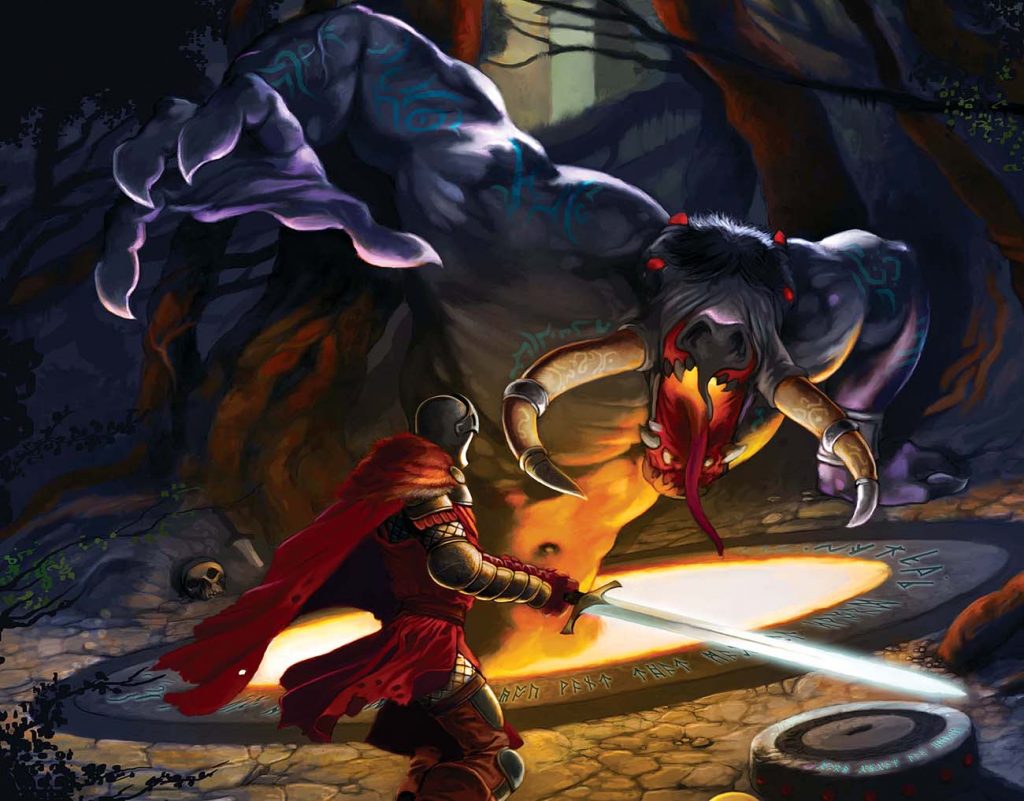
Players Handbook
The book starts with an ‘Acknowledgements’ section thanking Gary Gygax for bringing role playing to all of us. I wanted to mention this, because it has become popular to condemn the creators of the game that started the RPG hobby. Without Gygax and TSR publishing D&D, most of us would never have heard of RPGs.
The Players Handbook provides everything needed to understand the game including: Classes, races, equipment, spells and core mechanics. The game is based on standard d20 mechanics. To make a check (determination of success) you roll a d20, add bonuses, and compare it to a target number and if you meet or exceed that value, you succeed. This mechanic will be familiar to most players.
The Castles & Crusades SIEGE EngineTM action resolution system is designed to streamline the mechanics and improve the flow of the game. C&C heavily leverages the basic attribute scores (strength, dexterity, constitution, intelligence, wisdom and charisma) instead of separate scores or rankings for things like skills. Depending on race and class, characters have 2 or 3 primary attributes and the rest are secondary. Tasks related to your primary attribute are easier, because the character is well practiced at those, whereas they are just average at secondary tasks.
The difficulty of a check (challenge class) is determined by adding the challenge base (12 primary or 18 secondary) and challenge level which is a variable representing the difficulty of the task. This system is used for all checks in the game making it easy to learn and apply to your game. The Castle Keeper can easily determine the difficulty of any action with simple addition and allowing the flow of the game to proceed with little interruption.
The Players Handbook advises the Castle Keeper (Game Master or DM) to be “judicious” in use of checks and to allow the “narrative development” to guide the game where possible. However, the book does provide guidance for which attribute is applicable for things like saving throws vs different effects and a whole host of tasks.
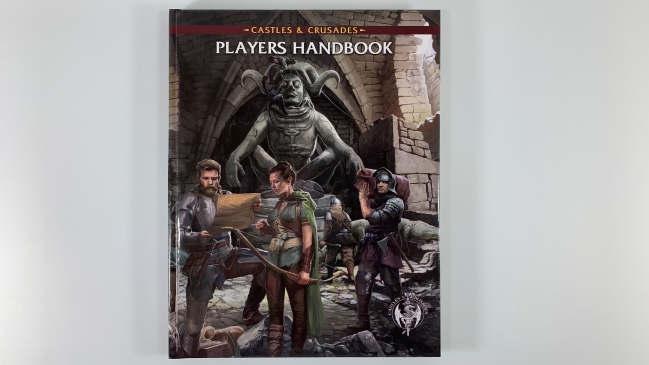
The combat system is similar to other d20 games, and each turn a character or monster takes one action, such as moving, attacking or casting a spell. Many other game systems allow a combination of actions in one turn. Either system works, but I think having a single action to consider will tend to speed up the action. The game also includes a variety of combat maneuvers and situational modifiers common in RPG combat.
Castles & Crusades has thirteen classes and seven races, and I think it is fair to say that they are inspired by 1e AD&D offerings which include the classes included in most fantasy RPGs including: the Cleric, Druid, Fighter, Monk, Paladin, Ranger, Rogue (Thief) and Wizards classes. Castles & Crusades also includes the Illusionist, Assassin, and Bard classes all of which appeared in 1e AD&D PHB, as well as a Knight (Cavalier) and Barbarian classes which appeared in the 1e Unearthed Arcana.
While that inspiration seems clear to see, C&C improves the presentation of the classes and class features. Many of these features are unique to a given class, which helps them remain distinct and interesting. Castles & Crusades does have a multi-classing system that is a bit different from other games and a ‘Class and a Half’ option that allows characters to supplement their characters with some features of another. So, if you do enjoy a character with a broader set of abilities, that is possible.
The races include: Dwarf, Elf, Gnome, Half-Elf, Halfling, Half-Orc and Human—classic RPG. Each race has unique features, and combined with the class options provide players a range of diverse options. One of the things I’ve always enjoyed are exploring the options and combinations for characters. The distinctiveness of classes and races greatly appeals to me and I look forward to stepping into those different roles in gameplay.
The Players Handbook is a clear, uniform presentation of game mechanics that are designed to promote a lot of interaction between players and the Castle Keeper and content that provides a classic fantasy feel.
Monsters & Treasure
I appreciate the cover art which is an homage of the original 1e AD&D Monster Manual. This tome provides all the information needed to understand the monsters that you might use as a Castle Keeper, including a glossary of monster characteristics, experience awards and commentary on creating your own monsters. The monster section is 311 pages packed with statistics and descriptions of fantasy monsters to challenge your players.
Unlike the classic Monster Manual, this book also includes 55 pages devoted to treasure and rewards. There are treasure tables, rules for creating magic items and a section on lands & titles as rewards. Of course, it also provides a large selection of classic magic items which I always enjoy browsing.
I like the coupling of monsters and treasure into one volume, which I think will provide Castle Keepers a bit of added convenience.
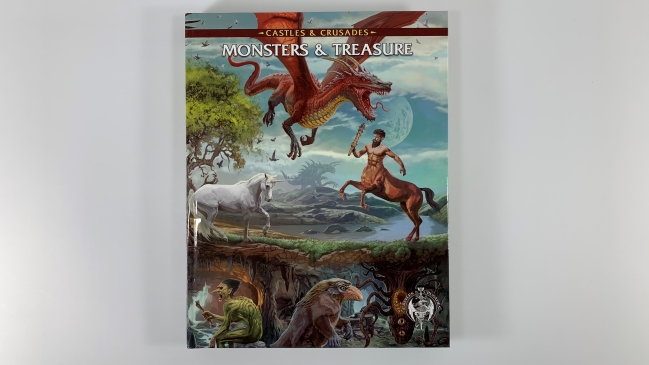
Castle Keepers Guide
The Castle Keepers Guide (CKG) starts with a discussion of the philosophy of running games and rules and then admits—it is in fact a book full of rules and options. The CKG reminds me a lot of the 1e DM’s guide delving into a wide range of topics including: Characters, magic, equipment/vehicles, and non-player characters. There is a chapter devoted to skills, expanding categories that characters might have in their background or develop over the course of a campaign.
In addition, the game has an optional Advantage system which is similar to Feats in 3e/3.5 D&D. It provides a means of representing characters that develop expertise in certain areas. This is an optional system for advanced play, rather than for standard use, for good reason. One of the issues with 3e based games is that players can be overwhelmed by options and different sub-systems. By default, Castles & Crusades sticks to the basics without an elaborate and extensive character design process.
The CKG presents discussions and information on world building, cities, dungeons, dealing with air and water-based adventures, war and additional sections on monsters and land ownership as reward. A chapter titled “The Future” is a discussion of differing technological levels and genres that your gaming group can explore.
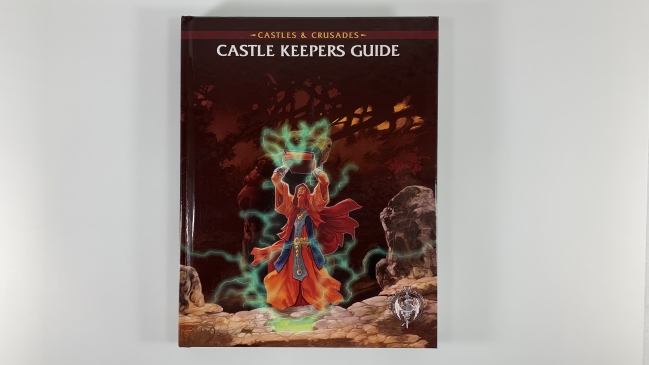
There are chapters delving into the SIEGE EngineTM and alternate applications, treasure, combat and advice on how to effectively run games and campaigns. These essays provide a lot of information based on decades of role playing experiences that bolster an Castle Keeper’s knowledge—any of which he or she can adapt to serve their game.
The 1e AD&D Dungeon Master’s Guide is considered by many to be the best writing on the subject of running a role playing game. The DMG contained a wealth of information, but I don’t think few would argue it is particularly accessible or easy to navigate. The Castle Keeper’s Guide is well organized and easy to find what you’re looking for. While I know how I like to run my campaigns, I think any game master can use a refresher or inspiration once in a while, so the CKG is one I plan to read cover to cover.
Screen, Adventure and Character Sheets
The bundle includes a four-panel Castle Keeper’s screen with lots of quick reference charts and a convenient way to hide your secret notes from curious players (see Castle Keepers Eye-view).
The adventure is titled ‘The Hallowed Ring’ and is a short (10 page) module leading characters on an overland journey to small dungeon in search of an amulet. While experienced game masters might be able to dive right into their own created games, I think it’s nice to warm up with a game system using a structured adventure.
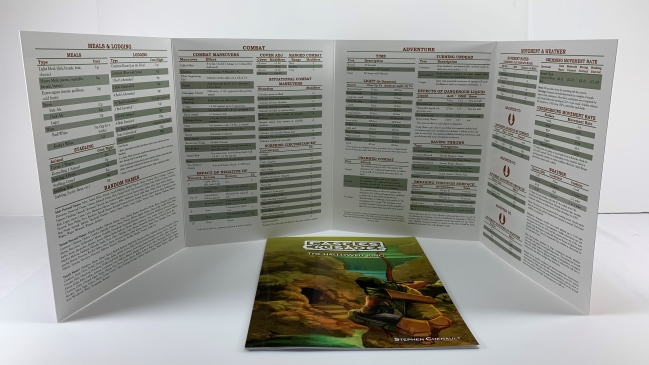
Now we get to one of my favorite bits—the character sheets. I often use spreadsheets to track characters and monsters, largely to keep track of all the mathematical variables, but there is nothing like a classic character sheet. The C&C Character sheets (left) are another homage to 1e AD&D character sheets (right). They even replicate the format which groups several classes with similar features together onto one sheet. I love the little extra thought they put into this, down to the goldenrod color–pretty close.
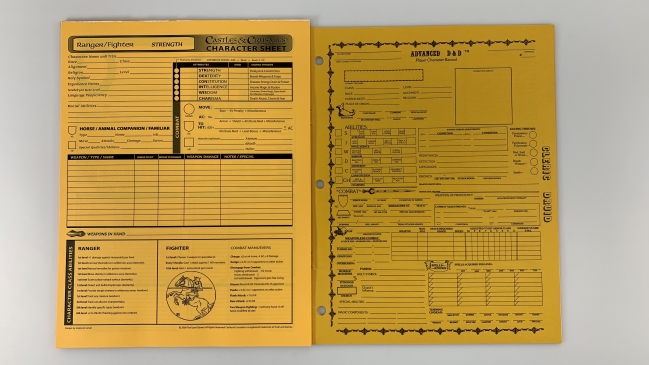
Summary
To reiterate, this is a first look, not an in-depth review, but Castles & Crusades looks like a well conceived and developed game. The mechanics are similar to those I have decades of experience with and it will be easy for me to use. In regards to the statement to claims that it is like 3e with a 1e flavor, that appears to be a reasonably accurate claim and I look forward to delving deeper into this game. Castles & Crusades isn’t a revolution in gaming, but a refinement and streamlining of a time-tested system, while retaining the flavor and feel of those classic RPGs.
You can check out Castles & Crusades in a number of ways.
You can download quick start rules and other material from the Bag of Holding.
You can also get a PDF copy of the entire Players Handbook 7th Printing for free on Troll Lord Games website.
Note: Scifi4Me.com has no affiliation with Troll Lord Games. TLG has not provided any materials, nor were they consulted in regards to this article.
![]()

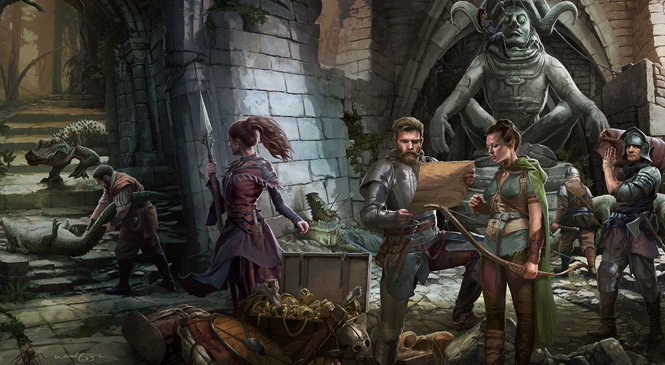


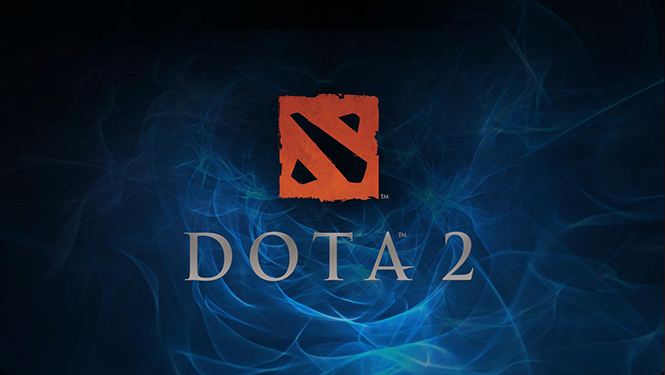
I haven’t played much C&C yet, but my players have enjoyed the sessions I’ve run so far. I’d like to run through the A series adventure modules at some point, after I’ve cleared some of my other games off my to-do list.
The folks who run Troll Lord Games are very accessible online and are very friendly. It’s been a welcoming community.
The nice thing about C&C is that it’s very easy to port in D&D adventure modules. AD&D and Basic modules are very easy to port over. 3rd or 4th ed modules will require a bit of work. 5th ed modules should be fairly simple, somewhere between AD&D and 3rd ed in difficulty. It should also be easy to bring in any other OSR-style games’ modules to C&C.